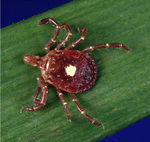Many of the hard tick species that infect animals in the UK are also present in other parts of Europe and the rest of the world information on these can be found here. There are many tick species that are important both in the effects of their ectoparasitism but also in their ability to transmit other infectious agents.
Ixodes spp.
Rhipicephalus spp.
These species were previously endiginous to the 'Old World', but have now been spread to a range of habitats worldwide and are important vectors of several infectious agents. They can generally be identified by;
- Inornate scutums
- Short palps
- Eyes present
- Festoons on posterior margin
- Comma shaped spiracles
Rhipicephalus sanguineus
This is an important tick worldwide but is discussed in the hard ticks UK section due to its relevance in kennels in the UK.
Rhipicephalus (Boophilus) microplus
| Also known as: | Tropical cattle tick
Southern cattle tick |
This is considered the most serious external parasites of Australian cattle, though they also affect cattle accross the southern hemisphere and the southern states of the USA. It is able to complete its life cycle in just 2 months under optimal conditions and lay 2000 - 3000 eggs during this time. It is important in its ability to act as a vector for Babesia bigemina, Borrelia theileri in South America and in Australia of Coxialla burnetti and Anaplasma marginale. These organisms can be passed down for up to 5 generations of ticks regardless of the hosts on which they feed as they can be passed transovarially between generations.
- Warmer climates
- Causes paralysis in livestock
- Vectors for diseases such as
- Theileria parva which causes East Coast Fever
- Babesia bigemina which affects ruminants, mainly in Africa
- Babesia canis and Ehrlichia canis which affects dogs in warmer climates worldwide
Boophilus spp.
These species are important due to their ability to transmit Babesia spp. and Anaplasma marginale in cattle. They exist in tropical and subtropical climates and so are predominately found in Asia, Africa, central America and northern Australia. There are several important veterinary species, all of which are one host ticks and are mainly important in cattle though they can be seen in most ungulates.
Boophilus annulatus
| Also known as: | Blue cattle tick
Texas cattle fever tick |
The entire life cycle of this tick is spent on a single host and can be completed in just 6 weeks. It is an important species as it is a vector for Babesia bigemina and Babesia bovis that are responsible for texas cattle fever. As well as its ability to transmit Anaplasma marginale like many other tropical hard ticks.
Amblyomma spp.
These ticks can be identified by;
- Large size
- Ornate scutums
- Eyes present
- Festoons
- Long palps
- Long legs
These ticks are distributed throughout tropical and sub-tropical areas of Africa as well as in temperate North America. The large mouth parts cause large painful bites and allow the females to ingest large volumes of blood which can lead to anaemia.
Amblyomma americanum
| Also known as: | Lone star tick |
This tick is found throughout central and eastern USA and is primarily important as a vector but has also been shown to reduce weight gain in cattle. It is responsible for transmission of Rickettsia rickettsii, Francisella tularensis, Q fever and Berrelia burgdorferi
Amblyomma variegatum
| Also known as: | Bont ticks
variegated or tropical bont tick |
Found throughout Africa, this tick is very important in its ability to transmit Cowdria ruminatium (heartwater) in Africa as well as viral Nairobi sheep disease and Q fever. There is distinct variation in the appearance of the males and female, the males are highly ornate with orange markings on the scutum compared to the brown female with a large pale patch on the scutum.
Hyalomma spp.
These are large ticks that are commonly found on the legs, udder, tail or perianal region of mammals. They are either two or three host ticks found in central Asia, southern Europe and North Africa. This is largely dependant Ticks of these species can identified by;
- Eyes present
- Long mouthparts
- Ventral plates around male anus
- Inornate
- Banded legs
Hyalomma anatolicum
| Also known as: | Bont-legged tick |
There are two subspecies known, H. anatolicum excavatum that is found in central Europe and Asia and H. anatolicum anatolicum which can be found throughout the rest of the range. These ticks cause tick toxicosis in Africa which is a sweating sickness seen in pigs and ruminants. This is accompanied by a profuse moist eczema and hyperaemia of the mucous membranes. This species can also be involved in the transmission of Theileria, Babesia spp. as well as Anaplasma marginale.
Hyalomma aegyptium
| Also known as: | Tortoise tick |
Infects tortoises in southern Europe and southwest Asia as well as lizards and occasionally dogs and horses. However this tick is being spread around the globe by the increasing pet trade in tortoises.
References
Pages in category "Hard Ticks - Overseas"
The following 5 pages are in this category, out of 5 total.
